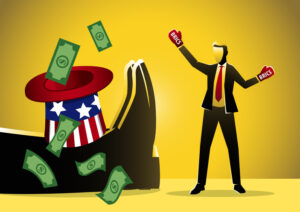
What The US Can Do to Halt De-Dollarization, According to One Think Tank Expert
The comments below are an edited and abridged synopsis of an article by Filip De Mott
The Dynamics of De-Dollarization and the Resilience of the US Dollar
The global landscape of currency dynamics is evolving, with increasing discussions around de-dollarization. However, the US possesses strategies to maintain the dollar’s dominance, according to Carla Norrlöf, a non-resident senior fellow at the Atlantic Council, in her interview with Project Syndicate.

The Rise of De-Dollarization
The trend of countries shifting away from the US dollar for trade and central bank reserves has gained momentum, especially among nations like Russia, China, and other BRICS states. This movement has prompted concerns about the potential erosion of the dollar’s hegemony in global trade and finance.
Despite this, Norrlöf remains skeptical about the immediate impact of de-dollarization. While the concept has garnered attention, she argues that it may not lead to significant changes in the near term. She notes that international conflicts are unlikely to cause a major shift away from the dollar, countering the prevalent belief that US sanctions are driving this trend.
Sanctions and the Dollar’s Dominance
“It is true that sanctions and other geostrategic measures could undermine the dollar’s dominance, but the risk is often overstated,” Norrlöf said. She emphasized that the dollar’s central role in global finance, bolstered by its extensive use in trade, financial markets, and foreign-exchange reserves, creates substantial barriers to any large-scale shift away from its use.
Efforts to promote alternative currencies and payment systems have not yet matched the reach and scale of the US dollar. Norrlöf pointed out that for a credible contender to emerge, there would need to be significant coordination among foreign economies, including US allies. To prevent such counter-coalitions, the US should focus on fostering healthy foreign policy and positive trade partnerships.
The Role of US Foreign Policy
“If other countries perceive the US as pursuing an overly aggressive or unilateral foreign policy, or enforcing biased policies at odds with the liberal international order it purports to support, they might seek to reduce the dollar’s influence over their economies,” Norrlöf explained. For instance, the potential seizure of Russian frozen assets could catalyze such a shift.
However, she also noted that it is unlikely for American allies to unite against the dollar. While China-led initiatives are ongoing, other countries would need to view any competitive currency as both safe and reliable.
Ensuring Dollar Stability
To curb the trend of de-dollarization, Norrlöf advocates for the US to actively pursue dollar stability through technological advancements in financial solutions, such as digital payments. This approach could mitigate the rise of regional substitute payment systems.
Furthermore, reinforcing the economic factors that underpin the dollar’s strength is crucial. This includes promoting domestic political stability to maintain confidence in the greenback. Internal challenges like runaway federal spending, political strife, and rising protectionism pose significant threats to the dollar’s dominance.
Conclusion
The discussion on de-dollarization underscores the complexities of global finance and the resilience of the US dollar. While the movement to diversify away from the dollar is gaining traction, the fundamental strengths of the dollar, coupled with strategic measures by the US, suggest that its dominance will persist. The key lies in balancing proactive foreign policy, technological innovation, and domestic stability to uphold the dollar’s central role in the global economy.
